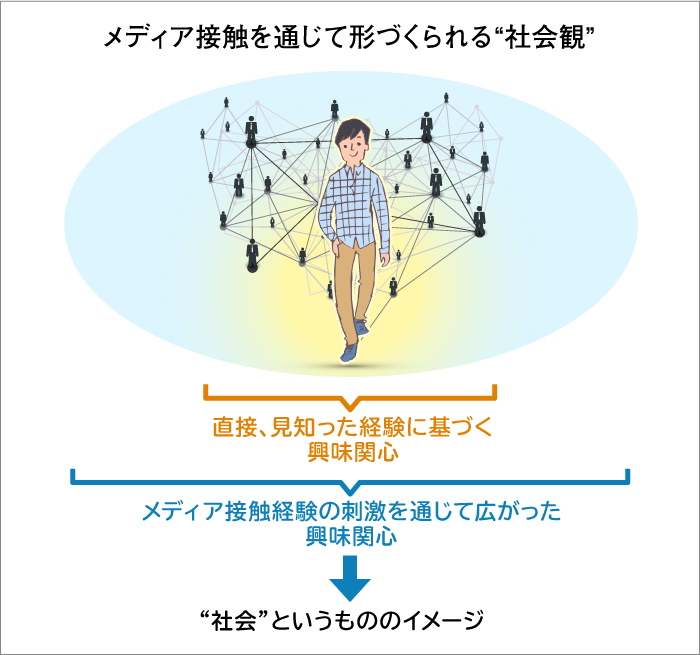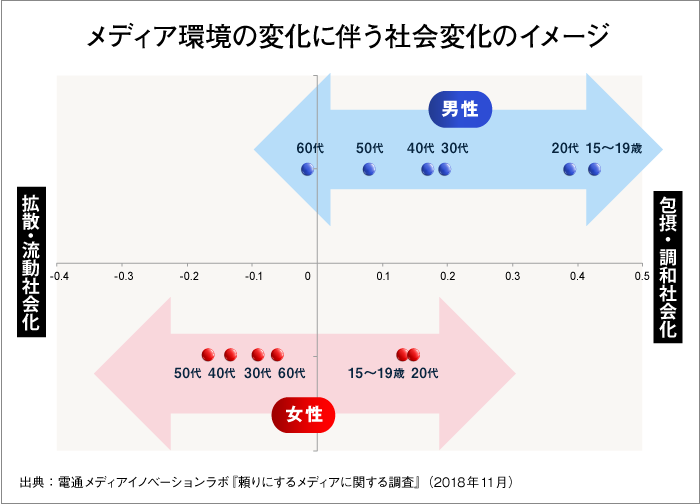The Cause of the "Sense of Incomprehension" Between Generations
This series, linked to the 'Information Media White Paper 2020', has now reached its fifth installment. The fourth installment introduced the younger generation's "media perspective." We confirmed that people use various social media platforms as filters to digest and process the diverse input information they receive from the world as individuals, making it their own through sharing and empathy. Social media seems to serve as a "bridge" when referencing other various media.
Now, the younger generation, who have acquired a new "media perspective" within the rapidly changing media environment of recent years, may also have a different "social perspective" compared to older generations. This is because "society" is shaped more by information encountered through various media and the interests cultivated there, rather than by direct personal experiences or interactions with those close to them. Consequently, a significant aspect of society can only be grasped through "image" (Figure 1).
[Figure 1]

If older generations currently feel a sense of "incomprehension" toward younger generations, might the cause lie in how the younger generation's perception of "society" has changed due to the rapid evolution of the media environment?
This time, we explore the "social outlook" held by the younger generation(※) by examining "how the younger generation perceives the impact of media environment changes on society."
※In this article, the younger generation is defined as those aged 15-49, and the older generation as those aged 50 and above. However, individuals in their 40s are considered a "bridge generation" between the younger and older generations and are included in the survey sample. This aims to facilitate clear interpretation of the survey results from the perspective of the older generation.
Two Polar Images: "Inclusion and Harmony" vs. "Dispersion and Fluidity"
In 2018, Dentsu Inc. Media Innovation Lab conducted a "Survey on Trusted Media" involving 4,412 respondents aged 15 to 69. Through 19 questions, it asked, "Given the impact of changes in the media environment, in what direction do you think society is changing?" When the responses were aggregated using a method called factor analysis, two distinct images emerged.
One factor was named "Inclusion and Harmony." "Inclusion" is a term increasingly used in social policy fields like disability support and LGBTQ+ support, referring to a state where diverse attributes and perspectives are recognized within society. In this survey, the image of "society changing towards 'inclusion and harmony'" refers to the idea that changes in the media environment make information more accessible to people. This allows diverse values and minority perspectives, which might otherwise be overlooked, to be reflected in society, making it easier for society to come together.
The "inclusion and harmony" factor correlates with a tendency toward affirmative responses ("Agree" or "Somewhat agree") to the following example questions:
・"A wide range of opinions and perspectives in society are shared throughout the world via the media."
・"Important information affecting many people is sufficiently disseminated through the media."
・"In today's society, information is readily available, making it easier for matters to be decided smoothly."
In contrast, what about "Dispersion and Fluidity"? This refers to the image that, due to changes in the media environment, an overflow of information has made the average feelings and thoughts of people in society more transient and difficult to discern.
The "Diffusion and Fluidity" factor correlates with a tendency toward affirmative responses to the following questions:
・"With more information sources, it's harder for people to find common ground on topics of mutual interest."
・"More people express unique opinions through media, causing societal norms to waver."
・"With more information, it's become harder to gauge where the average public opinion stands."
The images of societal change perceived through these two factors seem quite polar opposite. People of the same generation, who have experienced the same changes in the media environment over the past decade or so, now hold two extreme images of societal change: "inclusion and harmony" versus "diffusion and fluidity."
Whether convincing or surprising, the younger generation holds a stronger "inclusion and harmony" image.
Which age groups hold these polar images—"inclusion and harmony" versus "dispersion and fluidity"—more strongly, and to what degree? Figure 2 quantifies the strength of these polar images and shows average values by gender and age group.
[Figure 2]

Interestingly, for both men and women, it was found that younger generations, centered around those in their teens and twenties, tend to perceive society as moving more toward "inclusion and harmony" due to changes in the media environment.
How should we interpret this result? It seems somewhat one-sided to conclude simply that young people entering the Reiwa era (especially males) have become more conservative compared to their predecessors (e.g., those in the 1970s when student movements were prevalent). Rather, I believe the current information environment—where one can select necessary information on demand from the constant stream delivered to smartphones anytime, anywhere—is fostering the formation of this "inclusive and harmonious" societal image.
The difference lies in whether one masters the new media environment
Indeed, the 'Information Media White Paper 2020' traces back to the motivations behind media engagement—the very 'media outlook' mentioned earlier —to explain what drives this formation of an 'inclusive and harmonious' societal image.
For example, it was confirmed that individuals who strongly perceive benefits from their daily media engagement—such as "sharing a sense of participation and belonging" or "differentiating themselves from others through knowledge, values, or style"—tend to feel a stronger image of "inclusive and harmonious" social change, even among the same younger generation.
Conversely, those who tend to strongly envision "diffusion and fluidity"-oriented social change are more likely to find benefits in media contact specifically within the younger generation, such as "gaining knowledge and insights they didn't previously have" and "understanding what topics are trending in society."
In other words, those who tend to envision "inclusive and harmonious" societal change do not confront society by abruptly contrasting "the world" with "themselves." Instead, as shown in Figure 1, they shape their "view of society" within a media environment seamlessly integrated into daily life via smartphones and SNS, primarily through close friends, acquaintances, and trusted information sources. In this sense, we can infer that these individuals are likely already well-adapted to and adept at navigating the new media environment.
Now, next time will be the final installment of this series. Within this new media environment, will the relationship between media and advertising change significantly? Finally, I'd like to consider this point based on the survey results.
Using this survey as a reference, students reflected on "Social Media and Social Participation Among Younger Generations."
DENTSU SOKEN INC. Website "International Christian University × University of Southern California Joint Program"






